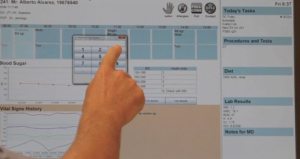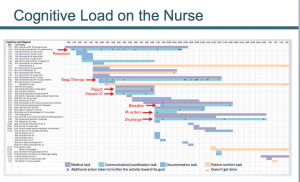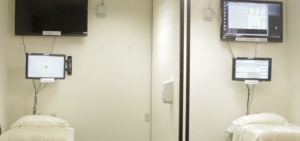The “Digital Nurse Assistant” (aka DNA project) was a joint project with a major health care provider in the Bay Area in 2011-2012. Maarten Sierhuis led the project in 2011 and the team created a demonstration system in PARC’s DNA lab. The project goal was to improve the quality of patient care in a hospital setting and to reduce cost by managing healthcare resources. In 2012, Peter Jarvis and I worked with a development team in Xerox Services to develop DNA as a product.
Health care providers in a hospital have different skills and specializations. Depending on their roles, providers may see three to a dozen patients during a shift. Ethnographers on the project followed nurses around in a hospital to observe them at work. We found that nurses spend a lot of their time prodding and unblocking others to get tasks done. Much time is wasted tracking down what others have done. Nurses are constantly interrupted for information by other clinicians and the patient’s family. The chart on the left shows how a nurse multi-tasks across many tasks for many patients.
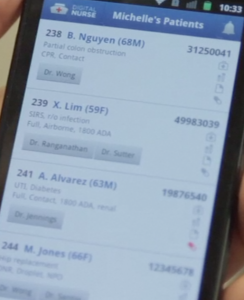 The adoption of electronic medical records is the technical response by the healthcare industry to improve the situation so that all patient information is online. As observers like Dr. Westby Fisher have noted, “Our healthcare information gold rush has required teams of programmers to feverishly implement … information system requirements … [but] these programmers have little perspective .. on how we interact with patients. We are in danger of not being able to find our most important clinical signals amongst the noise and clutter of all the data.” Most information is in the EMR somewhere, but it’s buried within a sea of information on dozens of screens.
The adoption of electronic medical records is the technical response by the healthcare industry to improve the situation so that all patient information is online. As observers like Dr. Westby Fisher have noted, “Our healthcare information gold rush has required teams of programmers to feverishly implement … information system requirements … [but] these programmers have little perspective .. on how we interact with patients. We are in danger of not being able to find our most important clinical signals amongst the noise and clutter of all the data.” Most information is in the EMR somewhere, but it’s buried within a sea of information on dozens of screens.
The DNA response to this was to design an information system on top of the EMR to put the right information in the right place at the right time. The DNA demo had two patient rooms, a charge nurse station, and a medication room. It used touch screens in the patient room (on the right and top), smart phones and tablets (above left), a unit overview display (below), and location sensors worn by nurses, and a network of computers to support this.
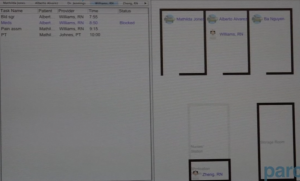 The project demo was a “digital nervous system” that connects not only the tablets, but also numerous data bases, sensors, and computing services for organizational computing. Just as “personal computing” amplifies and empowers individuals, organizational computing amplifies and empowers organizations, effectively enabling them to tap into the distributed intelligence of their human and computational agents.
The project demo was a “digital nervous system” that connects not only the tablets, but also numerous data bases, sensors, and computing services for organizational computing. Just as “personal computing” amplifies and empowers individuals, organizational computing amplifies and empowers organizations, effectively enabling them to tap into the distributed intelligence of their human and computational agents.
The DNA project included ethnographers, software engineers, and workflow modelers from two PARC laboratories. Project members included Maarten Sierhuis, Peter Jarvis, John Maxwell, Kristian Lyngbaek, Ellen Isaacs, and Erik Vinkhuyzen.
News Reports and Promotional Spots
- [Animated Video] Xerox promotional ad using DNA to explain achieving simplicity in healthcare.
- [Med Gadget] Xerox Digital Nurse Assistant Display Relevant Data Upon Entering Patient Rooms.
- [The Healthcare Blog] Interview with Markus Fromherz.

